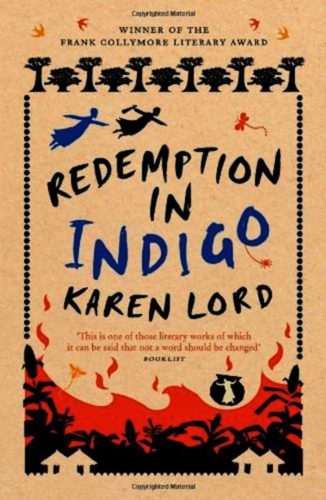April finds me in a mischievous mood, the joyful memories of Easters past working their way around my subconscious. It’s a season of quick laughter and a hunger for fun, which made me crave a book about tricksters and mischief makers, and the chaotic energy they radiate.
For this reason, I am returning to the first Caribbean science fiction novel I have ever read: Redemption in Indigo by Karen Lord. This book never fails to make me chuckle. It combines a folktale, folklore characters, metaphysical concepts and science with Lord’s quick wit, humour and masterful rendering of traditional oral storytelling. This blend makes Redemption in Indigo a delightful and entertaining read.
“There was something else about
Paama that distracted people’s
attention from any potentially juicy
tidbits of her past. She could cook.

“An inadequate statement. Anyone can cook, but the true talent belongs to those who are capable of gently ensnaring with their delicacies, winning compliance with a mere suggestion that there might not be any goodies for a caller who persisted in praying. Such was Paama…Besides [her cooking] kept Paama busy enough to ignore the nagging question of how she was going to tell Ansige she was never coming back.” – pp. 3-4
Paama is an ordinary woman who lives with her parents and younger sister in Makendha. However, there are two things that make her stand out to the villagers: her exceptional talent as a cook, and her tactful silence about the state of her marriage. Paama left her husband, Ansige, two years prior to the events that open Redemption, and since then the villagers have been trying to find out why.
Unfortunately for Paama, Ansige decides to come search for her himself. Unfortunately for Ansige, there are forces working in the shadows – the djombi (pronounced ‘jumbie’) as Paama’s people call them – intent on making his sojourn and arrival in Makendha an eventful one. When Ansige shows up one week behind schedule, he has a series of misadventures, all stemming from a gluttony so ferocious, that he often runs belly first into the shenanigans ranging from silly to dangerous.
Paama tries her best to use both her cooking and wit to sate the gluttonous Ansige and bail him out of trouble, but ultimately Ansige is forced to leave Makendha in shame while Paama stays behind.
The djombi have been trying to influence Paama as well, trying to urge her into laughing at Ansige or gossiping about him with her nosey neighbours. However, either Paama ignores the urges or is immune to their influence. This tact earns her respect from the villagers and from the senior djombi who have been observing her from afar. Satisfied that Paama is not one to be influenced by the meddlesome junior djombi that provoke Ansige’s antics, they choose her to wield a strange power by offering her an artifact called The Chaos Stick and teaching her how to use it.
But the power within the Chaos Stick once belonged to another senior djombi, known as the Indigo Lord, who is intent on finding it and retrieving it. Thus begins Paama’s bizarre adventures, as she’s meets both benevolent and malevolent djombi, each intent on using her and her new power for their own devices. Chaos follows. Lives are changed and reshaped, and Paama is forced to embrace new knowledge, roles and possibilities.
By the end of her misadventures, there is a chance of redemption for Paama and everyone involved in her chaotic story.
The Narrator as a Character
A part of the reason I enjoyed Redemption in Indigo so much was because of its narrator. Lord renders oral story techniques on the page through a narrator whose voice is so distinct and powerful that they become a character themself. In doing so, Lord creates a novel that is both told and shown. The narrator blends a third-person recounting of the story with several second-person interjections. Sometimes they tell the audience a little about themself, or they interrupt to directly clarify plot points, or give justifications for their narrative choices.
In doing so, Lord is sneaking in a second story into the narrative: firstly, there is the story being told to us by the narrator; secondly, there is the story of the narrator telling the story.
For example, the opening lines of the book read “A rival of mine once complained that my stories begin awkwardly and end untidily. I am willing to admit to many faults, but I will not burden my conscience with that one.”
This sentiment about untidy endings to stories is referenced several times as the story goes on, especially when characters make unexpected decisions, or there are bizarre plot twists. The narrator is especially sensitive to criticism about having open-ended story conclusions, seemingly ready to fight their audience at some points. Amusingly, though, they begrudgingly relent to add an epilogue, but only because the audience demands it. Together, these clues hint to the reader that the narrator has a life beyond telling us this story, full of its own conflicts.
The narrator’s wit, sass, analysis and mild self-indulgent grumbles shape Redemption in Indigo by making it an engaging and dynamic retelling rather than a stagnant recitation of events. In doing so, Lord honours the oral storytelling traditions that shaped the folktale the novel is based on, while also making the book immensely entertaining.
Folktale retellings
Redemption in Indigo is a retelling of a Senegalese folktale about Ansige Karamba the Glutton. It was interesting to see how Lord used the source material as a base from which to expand outward, encompassing more characters, themes and concepts.
Lord opens with an embellished retelling of the original folk story, using it to introduce us to the world and its characters. She also gives us the sense that humans are not this world’s only occupants, having to share it with the mysterious djombi who impact everyday life in both simple and monumental ways. Ansige owes some of his trouble to their direct and indirect influences, which helps us to understand the way some of them work.
Afterward, the story focuses mainly on Paama and her interactions with the djombi. The djombi themselves are agents of metaphysical and scientific concepts such as patience, chance and probabilities, and chaos. The djombi power Paama wields is called “chaos”, but it manifests as entropy around her, rearranging the particles around her — the dust on the village paths, the ripples in the river as she does her laundry, and even the patterns of candy she makes — into its rare patterns that couldn’t just be formed by the random chaos in her universe.
Metaphysically, there are djombi who stand for more abstract concepts. For example, one of the djombi who helps Paama calls itself “Constancy-in-Adversity” and “Senseless-Resignation-to-Suffering”, which reference a specific kind of patience. I also found Lord’s version of a baccou (baccoo) interesting since in the story, it is an entity that eradicates self-absorption by forcing literal self-reflection. While it does deviate from its many renditions in Caribbean folklore, the rebrand feels natural in Redemption in Indigo, and fits in well with the rest of the djombi.
Playing in Space-Time
Lastly, I really love the way this story played with space and time, both within the core story and its narration. The narrator themselves note that they cannot tell whether the events within Redemption in Indigo happened in “a time that was, or a time that is, or a time that is to come”. When introducing the first character in the book, the narrator is equally vague about his origins, identifying him only as a man “born in a certain country in a certain year when history had reached that grey twilight in which fables of true love, the power of princes and deeds of honour are told only to children.”
Time and Space are further complicated in the story. During Ansige’s journey to Makendha, he uses a mule caravan at one point, and then an omnibus – which could either mean a large bus or a large horse-drawn carriage – during the last stretch when he is alone. Paama uses mostly coinage during her adventures, but has to pawn her gold coin for bank notes and dull coins during one part of her travels with the djombi. Then, when interacting, the djombi themselves move beyond the restrictions of space-time, being able to move through time and space non-linearly, and even see past, present and future almost concurrently.
Throughout the reading, we get a sense of the universality of this story. It can truly be about anyone from anywhere during any time. This makes the story simultaneously as simple and complex, like any traditional fairy-tale or folkstory. Although, the science fiction elements and metaphysical concepts divert the story slightly from its traditional roots, thus making the reading experience pleasantly trippy, diverting somewhat from those traditional roots.
Conclusion
I admit that before my first reading, I seriously misjudged Redemption in Indigo. I had expected something high-brow and dense and tough to get into. I am glad that I was so terribly wrong because the book was a pleasant surprise. The narrator all but welcomes you in, offers you a seat and snacks before easing you into an easily bingeable story full of vibrant characters. It’s truly the kind of story that would put anyone in a good mood.
So, if you’re like me and April has you craving a good laugh or just a fun read, I highly suggest you adding this one to your collection. I promise it will make your day a little lighter.
Thank you, Karen Lord, for answering a few of the questions I had about this novel. Your input made this review possible.
Want to read more work by Karen Lord? Check out:
The Best of All Possible Worlds
The Galaxy Game
Unravelling (the sequel to Redemption in Indigo)
Curious about the folktale at the heart of Redemption in Indigo? Scan the QR code below for a video about the original folktale.








